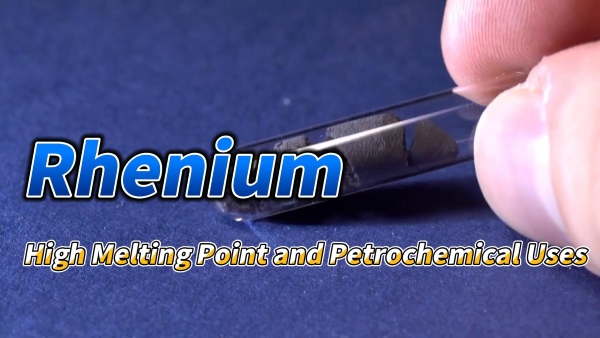Rhenium: A Comprehensive Guide

Rhenium is a rare and highly valuable transition metal with extraordinary properties that make it indispensable in aerospace, catalysis, and electronic applications.

Rhenium the Element
With an atomic number of 75 and a unique electron configuration ([Xe] 4f¹⁴ 5d⁵ 6s²), rhenium belongs to the group of refractory metals known for their high melting points and excellent mechanical strength. Discovered in 1925 by German chemists Ida Noddack, Walter Noddack, and Otto Berg, rhenium was one of the last naturally occurring elements to be identified. Today, it plays a critical role in high-performance industries due to its exceptional heat resistance, corrosion resistance, and catalytic properties.
Properties of Rhenium
Re possesses several unique physical, chemical, and mechanical characteristics that distinguish it from other elements.
- It has a melting point of 3,180°C (5,756°F), the third highest of all elements, after tungsten and carbon. It also has a boiling point of 5,627°C (10,161°F), making it ideal for extreme-temperature environments. With a density of 21.02 g/cm³, rhenium is among the densest elements, slightly less dense than platinum and iridium.
- Chemically, Re exhibits multiple oxidation states, ranging from -1 to +7, with +7 being the most stable and common. This flexibility in oxidation states makes rhenium a key component in catalytic reactions. The metal is highly resistant to corrosion and oxidation at high temperatures, even in the presence of aggressive environments such as strong acids.
- Re also has exceptional ductility, allowing it to be drawn into fine wires without breaking, making it ideal for electrical applications.
Production and Sources
Rhenium is one of the rarest elements in the Earth's crust, with an estimated abundance of only 1 part per billion (ppb). Unlike many other metals, Re does not form its own minerals but occurs as a trace element within molybdenite (MoS₂), a primary source of molybdenum. The average concentration of rhenium in molybdenite is between 100 and 2,000 parts per million (ppm), depending on the deposit.
The extraction of rhenium is a byproduct of copper and molybdenum mining, particularly from porphyry copper deposits in Chile, the United States, Kazakhstan, and Poland. The production process typically involves roasting molybdenite concentrates, which releases rhenium as rhenium heptoxide (Re₂O₇) in the off-gases. This oxide is then dissolved in water, purified, and reduced using hydrogen to obtain metallic rhenium powder.
Applications of Rhenium
--Aerospace and Superalloys
One of the most important applications is high-temperature superalloys, particularly jet engines and gas turbines. Re is alloyed with nickel-based superalloys to enhance their strength, creep resistance, and thermal stability. These alloys can withstand temperatures exceeding 1,100°C (2,012°F) without significant degradation.
As a result, rhenium-containing turbine blades improve fuel efficiency and reduce maintenance costs in modern aircraft engines. Approximately 70% of the world's rhenium supply is used in aerospace applications.
--Catalysis in the Petrochemical Industry
Re plays a crucial role in the petroleum refining industry as a key component in platinum-rhenium catalysts. These catalysts are used in catalytic reforming processes to produce high-octane gasoline and to improve hydrocracking efficiency.
The addition of rhenium enhances the catalyst’s resistance to sulfur poisoning and extends its operational lifespan, reducing the need for frequent replacement. Given the increasing demand for cleaner fuels and higher energy efficiency, rhenium's role in catalytic processes remains essential.
--Electronics and Medical Applications
Re is also used in electrical and electronic applications due to its high electrical conductivity and stability under extreme conditions. It is commonly employed in filaments for mass spectrometers, thermocouples for high-temperature measurement, and electrical contacts in critical aerospace and industrial applications.
In the medical field, rhenium-188 and rhenium-186 isotopes are used in radiopharmaceuticals for targeted cancer therapy and bone pain relief.
Market Trends and Challenges
Due to its rarity and dependence on molybdenum mining, rhenium's supply is limited, leading to significant price fluctuations. Over the past decade, rhenium prices have ranged from $1,000 to $3,000 per kilogram, depending on demand and geopolitical factors. The aerospace industry's reliance on rhenium-containing superalloys drives global demand, making the metal highly valuable.
Efforts to recycle Re from spent catalysts, turbine blades, and electronic components have gained momentum to ensure a sustainable supply. Companies are investing in advanced recovery techniques to extract rhenium efficiently from secondary sources. However, alternative materials and superalloy formulations are being explored to reduce reliance on rhenium, particularly in next-generation jet engines.
Summary Table: Rhenium Uses
To better understand rhenium's applications, the following table provides an overview of its key uses:
|
Application |
Percentage of Total Usage |
Primary Benefit |
|
Aerospace (Superalloys) |
~70% |
High-temperature strength and creep resistance |
|
~20% |
Improves efficiency and longevity of catalysts |
|
|
Electronics (Thermocouples, Filaments) |
~5% |
High electrical conductivity and thermal stability |
|
Medical (Radiopharmaceuticals) |
~2% |
Used in cancer treatment and medical imaging |
|
Other Industrial Uses |
~3% |
Corrosion resistance and specialized applications |
Conclusion
The high melting point, corrosion resistance, and ability to form superalloys of Rhenium contribute to its widespread use in modern technology. Despite supply limitations and price volatility, rhenium remains a critical material for industries requiring high-performance materials. As research continues into recycling methods and alternative alloys, the role of rhenium in advanced engineering applications is likely to evolve. For more refractory metal products, please check Advanced Refractory Metals (ARM).
{{item.content}}
LEVE A REPLY
{{item.children[0].content}}
{{item.content}}






